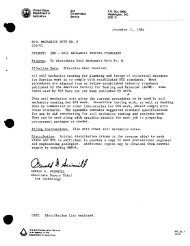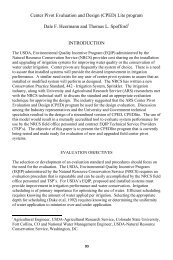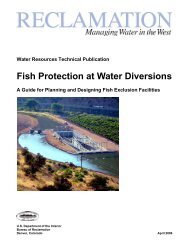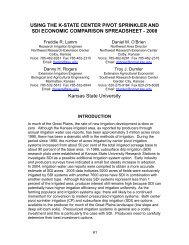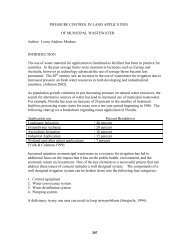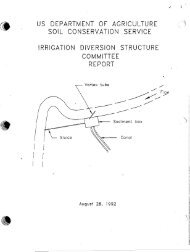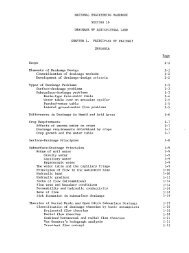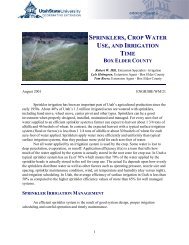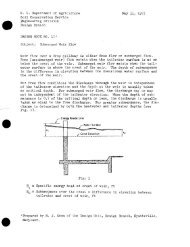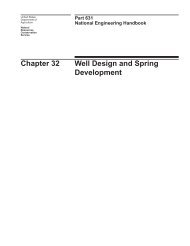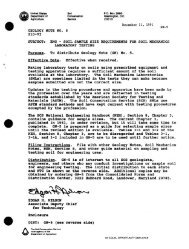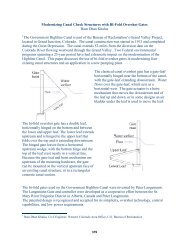Chapter 11: Sprinkle Irrigation - NRCS Irrigation ToolBox Home Page
Chapter 11: Sprinkle Irrigation - NRCS Irrigation ToolBox Home Page
Chapter 11: Sprinkle Irrigation - NRCS Irrigation ToolBox Home Page
You also want an ePaper? Increase the reach of your titles
YUMPU automatically turns print PDFs into web optimized ePapers that Google loves.
Linear-Move Lateral<br />
Self-propelled linear-move laterals combine the<br />
structure and guidance system of a center-pivot<br />
lateral with a traveling water feed system similar to<br />
thal: of a traveling sprinkler.<br />
Linear-move laterals require rectangular fields<br />
free from obstructions for efficient operation. Measured<br />
water distribution from these systems has<br />
shown the highest uniformity coefficients of any<br />
system for single irrigations under windy conditions.<br />
Systems that pump water from open ditches<br />
must be installed on nearly level fields. Even if the<br />
system is supplied by a flexible hose, the field must<br />
be fairly level in order for the guidance system to<br />
work effectively.<br />
A major disadvantage of linear-rnove systems as<br />
compared to center-pivot systems is the problem of<br />
bringing the lateral back to the starting position<br />
and across both sides of the water supply line.<br />
Since the center-pivot lateral operates in a circle, it<br />
automatically ends each irrigation cycle at the Feginning<br />
of the next, but because the linear-move<br />
lateral moves from one end of the field to the other<br />
it must be driven or towed back to the starting<br />
position. However, the linear-move system can irrigate<br />
all of a rectangular field, whereas the centerpivot<br />
system can irrigate only a circular portion of<br />
it.<br />
Other <strong>Sprinkle</strong> Systems<br />
Because of the recent concerns about availability<br />
and cost of energy, interest has revived in the use<br />
of perforated pipe, hose-fed sprinklers run on a grid<br />
pattern, and orchard systems. They afford a means<br />
of very low pressure (5 to 20 psi) sprinkle irrigation.<br />
Often, gravity pressure is sufficient to operate the<br />
system without pumps. Furthermore, inexpensive<br />
low-pressure pipe such as unreinforced concrete and<br />
thin-wall plastic or asbestos cement can be used to<br />
distribute the water. These systems do have the<br />
disadvantage of a high labor requirement when<br />
being moved periodically.<br />
Perforated Pipe<br />
This type of sprinkle irrigation has almost become<br />
obsolete for agricultural irrigation but continues<br />
to be widely used for home lawn systems.<br />
Perforated pipe systems spray water from <strong>11</strong>16-in-<br />
diameter or smaller holes drilled at uniform distances<br />
along the top and sides of a lateral pipe. The<br />
holes are sized and spaced so as to apply water uniformly<br />
between adjacent lines of perforated pipeline<br />
(fig. <strong>11</strong>-10). Such systems can operate effectively at<br />
pressures between 5 and 30 psi, but can be used<br />
only on coarse-textured soils such as loamy sands<br />
with a high capacity for infiltration.<br />
Figure ll-10.-Perforoled<br />
Hose-Fed <strong>Sprinkle</strong>r Grid<br />
pipe lateral in opcration.<br />
These systems use hoses to supply individual<br />
small sprinklers that operate at pressures as low as<br />
5 to 10 psi. They can also produce relatively uniform<br />
wetting if the sprinklers are moved in a systematic<br />
grid pattern with sufficient overlap. However,<br />
these systems are not in common use except<br />
in home gardens and turf irrigation, although they<br />
do hold promise for rather broad use on small farms<br />
in developing countries where capital and power resources<br />
are limited and labor is relatively abundant.<br />
Orchard <strong>Sprinkle</strong>r<br />
A small spinner or impact sprinkler designed to<br />
cover the space between adjacent trees with little or<br />
no overlap between the areas wetted by neighboring<br />
sprinklers. Orchard sprinklers operate at pressures<br />
between 10 and 30 psi, and typically the diameter<br />
of coverage Is between 15 and 30 ft. They are located<br />
under the tree canopies to provide approximately<br />
uniform volumes of water for each tree. Water<br />
should be applied fairly evenly to areas wetted,<br />
although some soil around each tree may receive little<br />
or no irrigation (fig. <strong>11</strong>-<strong>11</strong>). The individual sprinklers<br />
can be supplied by hoses and periodically<br />
moved to cover several positions or n sprinkler can<br />
be provided for each position.



